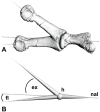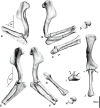Forearm Range of Motion in Australovenator wintonensis (Theropoda, Megaraptoridae)
- PMID: 26368529
- PMCID: PMC4569425
- DOI: 10.1371/journal.pone.0137709
Forearm Range of Motion in Australovenator wintonensis (Theropoda, Megaraptoridae)
Abstract
The hypertrophied manual claws and modified manus of megaraptoran theropods represent an unusual morphological adaptation among carnivorous dinosaurs. The skeleton of Australovenator wintonensis from the Cenomanian of Australia is among the most complete of any megaraptorid. It presents the opportunity to examine the range of motion of its forearm and the function of its highly modified manus. This provides the basis for behavioural inferences, and comparison with other Gondwanan theropod groups. Digital models created from computed tomography scans of the holotype reveal a humerus range of motion that is much greater than Allosaurus, Acrocanthosaurus, Tyrannosaurus but similar to that of the dromaeosaurid Bambiraptor. During flexion, the radius was forced distally by the radial condyle of the humerus. This movement is here suggested as a mechanism that forced a medial movement of the wrist. The antebrachium possessed a range of motion that was close to dromaeosaurids; however, the unguals were capable of hyper-extension, in particular manual phalanx I-2, which is a primitive range of motion characteristic seen in allosaurids and Dilophosaurus. During flexion, digits I and II slightly converge and diverge when extended which is accentuated by hyperextension of the digits in particular the unguals. We envision that prey was dispatched by its hands and feet with manual phalanx I-2 playing a dominant role. The range of motion analysis neither confirms nor refutes current phylogenetic hypotheses with regards to the placement of Megaraptoridae; however, we note Australovenator possessed, not only a similar forearm range of motion to some maniraptorans and basal coelurosaurs, but also similarities with Tetanurans (Allosauroids and Dilophosaurus).
Conflict of interest statement
Figures









References
-
- Bryan SE, Cook AG, Allen CM, Siegel C, Purdy DJ, Greentree JS, et al. Early—mid Cretaceous tectonic evolution of eastern Gondwana: From silicic LIP to continental rupture. Episodes Special Issue, Oceania Geology. 2012; 35(1): 142–152.
-
- White MA, Falkingham PL, Cook AG, Hocknull SA, Elliott DA. Morphological comparisons of metacarpal I for Australovenator wintonensis and Rapator ornitholestoides: implications for their taxonomic relationships. Alcheringa. 2013; 37: 1–7.
MeSH terms
LinkOut - more resources
Full Text Sources
Other Literature Sources

